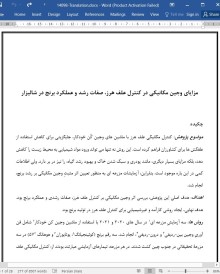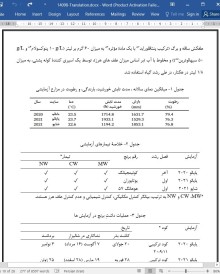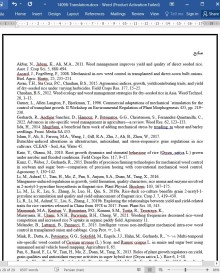
دانلود مقاله مزایای وجین مکانیکی در کنترل علف هرز، صفات رشد و عملکرد برنج در شالیزار
چکیده
موضوع پژوهش: کنترل مکانیکی علف هرز با ماشین های وجین کُن خودکار، جایگزینی برای کاهش استفاده از علفکش ها برای کشاورزان فراهم کرده است. این روش نه تنها می تواند ورود مواد شیمیایی به محیط زیست را کاهش دهد، بلکه مزایای بسیارِ دیگری، مانند پودری و سبک شدن خاک و بهبود رشد گیاه، را نیز در بر دارد. ولی اطلاعات کمی در این باره موجود است. بنابراین، آزمایشات مزرعه ای به منظور تعیین اثر مثبتِ وجین مکانیکی بر رشد برنج، انجام شد.
اهداف: هدف اصلی این پژوهش، بررسی اثر وجین مکانیکی بر کنترل علف هرز، صفات رشدی و عملکرد برنج بود. هدف نهایی، ایجاد روشی کارآمد و غیرشیمیایی برای کنترل علف هرز در تولید برنج بود.
روش ها: سه آزمایشِ مزرعه ای در سال های 2020 و 2021 با استفاده از ماشین وجین کن خودکار شامل فن آوریِ وجین بین-ردیفی و درون-ردیفی ، انجام شد. سه رقم برنج (کوئینجیانگ ، یوتایوزان و هوهانگ 57) در سه مزرعۀ تحقیقاتی در جنوب چین کشت شدند. در هر مزرعه، تیمارهای آزمایشی عبارتند بودند از: کنترل مکانیکی علف هرز و کنترل شیمیایی علف هرز. گیاهانی که کنترل علف هرز، روی آنها انجام نشد، به عنوان شاهد (تیمار کنترل) در نظر گرفته شدند. کارآییِ کنترل علف هرز و چگونگی عملکرد گیاه اندازه گیری شد.
نتایج: یافته ها نشان دادند که وجین مکانیکی با استفاده از وجین کُنِ خودکار، کارآیی بالایی در کنترل علف هرز (سه هفته پس از وجین) داشت (به طور متوسط 80%) و همچنین زمان و نیروی کار لازم برای مدیریت علف هرز را کاهش داد. وجین مکانیکی (در مقایسه با کنترل شیمیایی علف هرز)، به طور معنی داری سبب افزایش تعداد پنجه (23-7 %)، مقادیرِ SPAD (7-3 %) و بیوماسِ (زیست توده) کل (45%) پس از مرحلۀ طویل شدنِ میان گره شد. همچنین، فعالیت آنزیم های سوپراکسیدازدسموتاز و پراکسیداز در برگ های بالایی را افزایش داد و سبب افزایش عملکرد دانه ( 11-2%) در مرحلۀ رسیدگی کامل و برداشت شد.
نتیجه گیری: وجین مکانیکی با استفاده از فن آوریِ وجینِ تجمعیِ بین ردیفی و درون ردیفی به کشاورزان، این اجازه را داد که از علف کش ها اجتناب کنند، بدون اینکه کاهشی در کارایی کنترل علف هرز و عملکرد دانه پیش آید. به دلیل اثر خاک-ورزیِ بین ردیفی و تحریک مکانیکی توسط وجین کُنِ خودکار، کنترل مکانیکی علف هرز سبب بهبود رشد برنج شد، که روشی کارآمد و غیرشیمیایی برای وجین در تولید برنج را فراهم می نماید.
اهمیت موضوع: پیشرفت دائمی این فن آوری، اهمیت زیادی برای توسعۀ کنترل علف هرز در مزارع دارد. این نتایج می توانند برای افزایش تولید با استفاده از روش های کنترل مکانیکیِ علف هرز و توسعۀ عملیات کشاورزیِ هوشمند در چین و نواحی آگرواکولوژیکی مشابه در سطح دنیا مورد استفاده قرار گیرند.
1. مقدمه
مشکل علف هرز در شالیزارها، یکی از عوامل اصلی کاهش عملکرد گیاه در تولید برنج است، چراکه علف های هرز، بخشی از منابع ضروری برای رشد گیاه برنج را مصرف می کنند. مدیریت علف هرز در شالیزارها، به میزان زیادی، وابسته به فصل است، دورۀ وجین کوتاه است، و به نیروی کارگری زیادی نیاز دارد، که این عوامل، چالش های بیشتری را ایجاد می کنند (Zhu et al., 2020). در نتیجه، کنترل علف هرز، جنبۀ مدیریتی مهمی در شالیزارها محسوب می شود. روش های کنترل علف هرز عبارتند از روش های شیمیایی، مکانیکی، بیولوژیکی، حرارتی، الکتریکی، و روش های مختلف کشت (Zeng et al., 2021). کنترل شیمیایی، به دلیل مزیت اقتصادی و صرفه جویی در نیروی کار، روش کارآمدی است که بسیار مورد استفاده قرار می گیرد، ولی ریسک بالایی در آلودگی ناشی از علفکش ها دارد. سیر تکاملی علف های هرزِ مقاوم به علف کش ها، کاراییِ کنترل شیمیایی را کاهش خواهد داد، و ممکن است اثرات مضرّی نیز بر رشد و عملکرد گیاه زراعی داشته باشد. با تجمع علفکش ها در زنجیرۀ غذایی، ممکن است بقایایی علفکش ها به بدن انسان وارد شوند. بنابراین، بسیاری از کشورها، به ویژه کشورهای اتحادیه اروپا، باید وابستگی به علفکش ها را کاهش دهند تا استفاده از استراتژی های مکانیکی کنترل علف هرز افزایش یابد (Melander et al., 2015). وجین مکانیکی، همیشه در طول تاریخ کشاورزی، یک روش جایگزینِ پایدار و سازگار با محیط زیست بوده است، و مهم ترین جایگزین برای کنترل شیمیایی علف هرز نیز می باشد (Van Der Weide et al., 2008; Kunz et al., 2015).
وجین مکانیکی، به عنوان فن آوریِ کنترل سریع علف هرز به جای استفاده از علفکش ها، هزینه های تولید و نیروی کار را کاهش داده است، و سبب افزایش کاراییِ وجین در سال های اخیر شده است. با توسعۀ سریع کشاورزی ارگانیک، این روش وجین، به طور رو به رشدی مورد علاقۀ تولیدکنندگان برنج ارگانیک قرار خواهد گرفت. بسیاری از پژوهش های دو دهۀ اخیر، بر تحقیق و توسعه در زمینۀ روش های کنترل مکانیکی علف هرز در مزارع برنج، تمرکز داشته اند (Van Der Weide et al., 2008; Melander et al., 2015) که عمدتاً تحت تأثیر سیاست های منطقه ای و روآوردن به تولید ارگانیک بوده- اند. تأکید اولیه بر مدیریت علف های هرزِ بین-ردیفی بوده است که بین ردیف های کشت رشد می کنند و آنها را می توان به راحتی با کولتیوارهای بین ردیفی مدیریت نمود (Melander et al., 2015). با این حال، چالش موجود در وجین مکانیکی، کنترل علف های هرز درون-ردیفی است. عملیات اخیر در وجین مکانیکی ِدرون ردیفی مانند هرَس زنی علف هرز ، وجین چرخان (Melander et al., 2015) و استفاده از وجین کُنِ انگشتی برای کنترل علف هرز، مورد مطالعه قرار گرفته اند (Ascard et al., 2008). این روش ها توسط هیچ سیستم هوشمندی هدایت نمی شوند، غیرانتخابی هستند و هنگام عبور از مناطقِ درون-ردیفی، کارکردشان به تفاوت بین ریشۀ گیاه و ریشۀ علف هرز، وابسته است. از آنجایی که ماشین های وجینِ درون-ردیفی هنگام کار در نزدیکیِ گیاهچه ها، به آنها آسیب می زنند، کشاورزان به عملیات دقیقی نیاز دارند تا خسارت به گیاهچه ها به حداقل برسد.
5. نتیجه گیری
فن آوری وجین تجمّعیِ بین ردیفی و درون ردیفی، توانست سطح بالایی از کارایی را در کنترل علف هرز (به طور میانگین، 80%) به مدت سه هفته پس از وجین، ایجاد نماید و همچنین زمان و نیروی کارگری در مدیریت علف- های هرز را برای کشاورزان کاهش دهد. در مقایسه با کنترل شیمیایی علف هرز، با اینکه روش کنترل مکانیکیِ علف هرز، ارتفاع گیاه را کاهش داد، ولی سبب افزایش تعداد پنجه (22-7 %)، مقادیر SPAD (2-8 %) و بیوماس کل (45%) پس از مرحلۀ طویل شدن میان گره ها شد، که این موارد، رشد گیاه برنج را بهبود بخشیدند. فعالیت آنزیم های سوپراکسیددسموتاز و پراکسیدازِ برگ گیاهانِ تحتِ وجین مکانیکی، به دلیل تحریک مکانیکی و اثر خاک ورزیِ بین ردیفیِ ماشین وجین کن، به طور معنی داری، بیشتر بود. بر اساس این مزایا، برنجِ وجین شده به روش مکانیکی، بالاترین عملکرد تئوری و برداشت را داشت، و به دلیلِ بیشتر بودنِ تعداد خوشه های بارور و درصد پرشدن دانه (در مقایسه با کنترل شیمیایی علف هرز) دارای 11-2 % افزایش عملکرد بود. پژوهش ما نشان داد که روش وجین مکانیکیِ درون و بین ردیفی با استفاده از ماشینِ خودکار، توانست بر عملکرد برنج بیفزاید و استفاده از نیروی کاری و ورود مواد شیمیایی به محیط زیست را کاهش دهد. پیشرفت مداوم ِاین فن آوریِ نوظهور، پتانسیل بالایی برای کشاورزیِ سازگار با محیط زیست در توسعۀ کنترلِ علف هرز در مزارع زراعی خواهد داشت. در تحقیقات آتی، آزمایشات باید اثر ماشین وجین کنِ خودکار بر صفات فیزیکی-شیمیایی خاک و میکروارگانیسم ها در شالیزارها را بررسی کنند، تا درک بهتری از مزایای دیگرِ کنترل مکانیکی علف هرز در محیط زیستِ رشد گیاهان زراعی حاصل گردد.
Abstract
Context Mechanical weed control method with autonomous weeding machine provides an alternative way for farmers to reduce the use of herbicides. This method can not only reduce the chemical load in the environment, but also have many other benefits, such as loosening soil and promoting plant growth. However, little is known in this regard. Therefore, field experiments were conducted to determine the benefits of mechanical weeding on rice growth.
Objective The main objective of this study was to investigate the effects of mechanical weeding on weed control, rice growth characteristics and yield. The ultimate goal was to provide an efficient, non-chemical weed control method for rice production.
Methods Three field experiments were conducted in 2020 and 2021 using an autonomous weeding machine that combined inter-row and intra-row weeding technologies. Three different rice cultivars (Qingyang, Yuetaiyouzhan, and Huahang 57) were grown in the three experimental sites in South China. At each site, the experimental treatments were mechanical weed control and chemical weed control. Plants with no weed control were taken as the control of the experiment. Weed control efficacy and crop performance were measured.
Results The results showed that mechanical weeding using the autonomous weeding machine was able to achieve a high level of weed control efficacy (on average 80 %) for three weeks after weeding, and also reduced farmers' time and labor for weed management. Mechanical weeding significantly increased the tiller numbers by 7–23 %, SPAD values by 3–7 %, as well as the total biomass by 45 % after the jointing growth stage, compared with the chemical weed control method. Furthermore, the mechanical weeding obviously increased the activities of superoxide dismutase and peroxidase in the uppermost leaves of rice plants and grain yield by 2–11 % at the harvest maturity stage.
Conclusion Mechanical weeding using the collectively inter-row and intra-row weeding technology was capable of avoiding using herbicides with no losses in weed control efficacy and grain yield. Due to the mechanical stimulation and inter-tillage effect of the autonomous driving weeding machine, the mechanical weed control method promoted rice growth, which provided an efficient and non-chemical weeding method for rice production.
Significance The continuing advancement of this emerging technology is of great significance to the development of weed control in field crops. The results could be used to enhance rice production using mechanical weed control methods and develop smart-agriculture practices in China and similar agroecological regions around the globe.
1. Introduction
The weed problem in paddy fields is one of the main factors reducing the crop yield in rice production because they use part of the resources that are essential for rice growth. Weed management in paddy fields has significant seasonality, short weeding period, and large amount of labor, which brings more challenges (Zhu et al., 2020). Consequently, weed control is perceived to be an important aspect of research in paddy field management. Weed control methods include chemical, mechanical, biological, thermal, electric, and cultural approaches (Zeng et al., 2021). Due to the advantages of economy and labor savings, chemical weed control is a frequently used and efficient method, but it has high risk of herbicides contamination. The evolution of herbicide-resistance weeds will decrease the efficacy of chemical weed control, and it may cause adverse effects on crop growth and yield as well. With the accumulation of layers in the food chain, there could be herbicide residues in human bodies. Therefore, many countries require to reduce their dependence on herbicides, especially the European Union, which promotes the adoption of mechanical weed control strategies (Melander et al., 2015).
Mechanical weeding has always been an environment-friendly, sustainable weeding substitute in agricultural history, and it is also the most important alternative to chemical weed control (Van Der Weide et al., 2008; Kunz et al., 2015). As a rapid weed control technology to replace herbicides, mechanical weeding has reduced production costs and labor force, and enhanced weeding efficiency in recent years. With the rapid development of organic agriculture, this weeding method is progressively more favored by organic rice producers. Research and development of mechanical weed control methods for rice has been the focus of many studies in the past two decades (Van Der Weide et al., 2008; Melander et al., 2015), mainly driven by regional policies and the transition to organic production. The primary emphasis has been on the management of inter-row weeds which grow between crop rows and can be easily managed by most inter-row cultivators (Melander et al., 2015). However, the challenge for mechanical weeding is to control the weeds in the intra-row area of crops. Current intra-row mechanical weeding practices such as weed harrowing, torsion weeding (Melander et al., 2015), and finger weeding have been studied for weed control (Ascard et al., 2008). These methods are not guided by any intelligent system and are non-selective, relying on weed-crop root differences when passing through intra-row areas. Since intra-row weeding machines tend to injure seedlings when operating near seedlings, farmers need precise alignment operations to minimize the damage to seedlings.
5. Conclusions
Collectively inter-row and intra-row weeding technology was able to achieve a high level of weed control efficacy (on average 80 %) for three weeks after weeding, and also reduced farmers’ time and labor for weed management. Compared with chemical weed control method, although mechanical weed control method reduced the plant height but increased the number of tillers by 7–22 %, SPAD values by 2–8 %, and total biomass by 45 % after the jointing growth stage, which promoted the rice growth. The superoxide dismutase and peroxidase activities of the leaves were significantly higher under the mechanical weeding due to the mechanical stimulation and inter-tillage effect of the weeding machine. Based on these benefits, the mechanically weeded rice had the highest theoretical and harvest yields, with yield increases of 2–11 % compared to chemical weed control, because of its higher number of productive panicles and percentage of grain filling. Our study showed that the inter-row and intra-row mechanical weeding method using the autonomous driving machine could increase rice yields while reducing labor use and chemical loads. Continuing advancement in this emerging technology will have a great potential for environment-friendly agriculture in the development of weed control in field crops. For future research, experiments should investigate the effect of autonomous weeding machine on soil physicochemical properties and microorganisms in paddy fields, so as to further understand the additional benefits of adopting mechanical weed control on the field crop growing environment.
چکیده
1. مقدمه
2. مواد و روش ها
2-1 ماشین وجین کن خودکار
2-2 توصیف مزارع آزمایشی
2-3 تیمارها و طرح آزمایشی
2-4 روش آزمایش
2-5 اندازه گیری ها
2-5-1 کارایی کنترل علف هرز
2-5-2 صفات فیزیولوژیک
2-5-3 تعیین فعالیت آنزیمی
2-5-4 بیوماسِ کل، اجزاء عملکرد و عملکرد دانه
2-6 تحلیل آماری
3. نتایج
3-1 کارایی کنترل علف هرز
3-2 صفات فیزیولوژیک
3-3 بیوماس و موفولوژی ریشه
3-4 فعالیت آنزیم های SOD و POD در بالاترین برگ
3-5 عملکرد دانه و اجزاء عملکرد
4. بحث
5. نتیجه گیری
تضاد منافع
دسترسی به داده ها
منابع
Abstract
1. Introduction
2. Materials and methods
2.1. Autonomous weeding machine
2.2. Description of the experimental sites
2.3. Experimental design and treatments
2.4. Experimental procedure
2.5. Measurements
2.5.1. Weed control efficacy
2.5.2. Physiological characteristics of rice plants
2.5.3. Determination of enzyme activities
2.5.4. Total biomass, grain yield components and grain yield
2.6. Statistical analysis
3. Results
3.1. Weed control efficacy
3.2. Physiological characteristics of rice plants
3.3. Rice biomass and root morphology
3.4. SOD and POD activities in the uppermost leave
3.5. Grain yield and yield components
4. Discussion
5. Conclusions
Declaration of Competing Interest
Acknowledgements
References
این محصول شامل پاورپوینت ترجمه نیز می باشد که پس از خرید قابل دانلود می باشد. پاورپوینت این مقاله حاوی 20 اسلاید و 5 فصل است. در صورت نیاز به ارائه مقاله در کنفرانس یا سمینار می توان از این فایل پاورپوینت استفاده کرد.
در این محصول، به همراه ترجمه کامل متن، یک فایل ورد ترجمه خلاصه نیز ارائه شده است. متن فارسی این مقاله در 8 صفحه (2100 کلمه) خلاصه شده و در داخل بسته قرار گرفته است.
علاوه بر ترجمه مقاله، یک فایل ورد نیز به این محصول اضافه شده است که در آن متن به صورت یک پاراگراف انگلیسی و یک پاراگراف فارسی درج شده است که باعث می شود به راحتی قادر به تشخیص ترجمه هر بخش از مقاله و مطالعه آن باشید. این فایل برای یادگیری و مطالعه همزمان متن انگلیسی و فارسی بسیار مفید می باشد.
بخش مهم دیگری از این محصول لغت نامه یا اصطلاحات تخصصی می باشد که در آن تعداد 50 عبارت و اصطلاح تخصصی استفاده شده در این مقاله در یک فایل اکسل جمع آوری شده است. در این فایل اصطلاحات انگلیسی (تک کلمه ای یا چند کلمه ای) در یک ستون و ترجمه آنها در ستون دیگر درج شده است که در صورت نیاز می توان به راحتی از این عبارات استفاده کرد.
- ترجمه فارسی مقاله با فرمت ورد (word) با قابلیت ویرایش و pdf بدون آرم سایت ای ترجمه
- پاورپوینت فارسی با فرمت pptx
- خلاصه فارسی با فرمت ورد (word)
- متن پاراگراف به پاراگراف انگلیسی و فارسی با فرمت ورد (word)
- اصطلاحات تخصصی با فرمت اکسل



